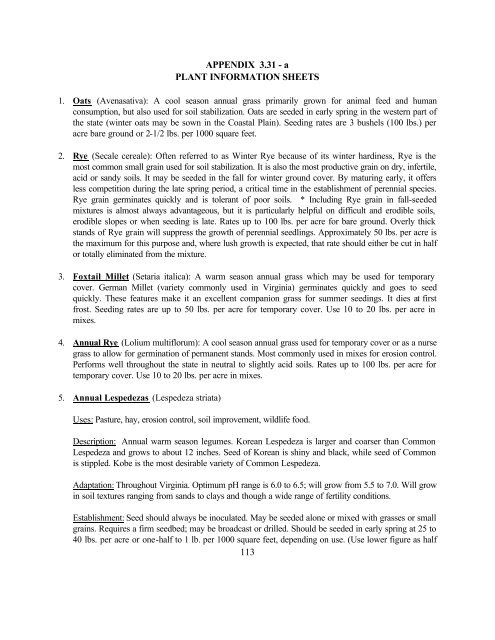APPLICANT PACKET - Virginia Department of Conservation and ...
APPLICANT PACKET - Virginia Department of Conservation and ...
APPLICANT PACKET - Virginia Department of Conservation and ...
Create successful ePaper yourself
Turn your PDF publications into a flip-book with our unique Google optimized e-Paper software.
APPENDIX 3.31 - a<br />
PLANT INFORMATION SHEETS<br />
1. Oats (Avenasativa): A cool season annual grass primarily grown for animal feed <strong>and</strong> human<br />
consumption, but also used for soil stabilization. Oats are seeded in early spring in the western part <strong>of</strong><br />
the state (winter oats may be sown in the Coastal Plain). Seeding rates are 3 bushels (100 lbs.) per<br />
acre bare ground or 2-1/2 lbs. per 1000 square feet.<br />
2. Rye (Secale cereale): Often referred to as Winter Rye because <strong>of</strong> its winter hardiness, Rye is the<br />
most common small grain used for soil stabilization. It is also the most productive grain on dry, infertile,<br />
acid or s<strong>and</strong>y soils. It may be seeded in the fall for winter ground cover. By maturing early, it <strong>of</strong>fers<br />
less competition during the late spring period, a critical time in the establishment <strong>of</strong> perennial species.<br />
Rye grain germinates quickly <strong>and</strong> is tolerant <strong>of</strong> poor soils. * Including Rye grain in fall-seeded<br />
mixtures is almost always advantageous, but it is particularly helpful on difficult <strong>and</strong> erodible soils,<br />
erodible slopes or when seeding is late. Rates up to 100 lbs. per acre for bare ground. Overly thick<br />
st<strong>and</strong>s <strong>of</strong> Rye grain will suppress the growth <strong>of</strong> perennial seedlings. Approximately 50 lbs. per acre is<br />
the maximum for this purpose <strong>and</strong>, where lush growth is expected, that rate should either be cut in half<br />
or totally eliminated from the mixture.<br />
3. Foxtail Millet (Setaria italica): A warm season annual grass which may be used for temporary<br />
cover. German Millet (variety commonly used in <strong>Virginia</strong>) germinates quickly <strong>and</strong> goes to seed<br />
quickly. These features make it an excellent companion grass for summer seedings. It dies at first<br />
frost. Seeding rates are up to 50 lbs. per acre for temporary cover. Use 10 to 20 lbs. per acre in<br />
mixes.<br />
4. Annual Rye (Lolium multiflorum): A cool season annual grass used for temporary cover or as a nurse<br />
grass to allow for germination <strong>of</strong> permanent st<strong>and</strong>s. Most commonly used in mixes for erosion control.<br />
Performs well throughout the state in neutral to slightly acid soils. Rates up to 100 lbs. per acre for<br />
temporary cover. Use 10 to 20 lbs. per acre in mixes.<br />
5. Annual Lespedezas (Lespedeza striata)<br />
Uses: Pasture, hay, erosion control, soil improvement, wildlife food.<br />
Description: Annual warm season legumes. Korean Lespedeza is larger <strong>and</strong> coarser than Common<br />
Lespedeza <strong>and</strong> grows to about 12 inches. Seed <strong>of</strong> Korean is shiny <strong>and</strong> black, while seed <strong>of</strong> Common<br />
is stippled. Kobe is the most desirable variety <strong>of</strong> Common Lespedeza.<br />
Adaptation: Throughout <strong>Virginia</strong>. Optimum pH range is 6.0 to 6.5; will grow from 5.5 to 7.0. Will grow<br />
in soil textures ranging from s<strong>and</strong>s to clays <strong>and</strong> though a wide range <strong>of</strong> fertility conditions.<br />
Establishment: Seed should always be inoculated. May be seeded alone or mixed with grasses or small<br />
grains. Requires a firm seedbed; may be broadcast or drilled. Should be seeded in early spring at 25 to<br />
40 lbs. per acre or one-half to 1 lb. per 1000 square feet, depending on use. (Use lower figure as half<br />
113
















